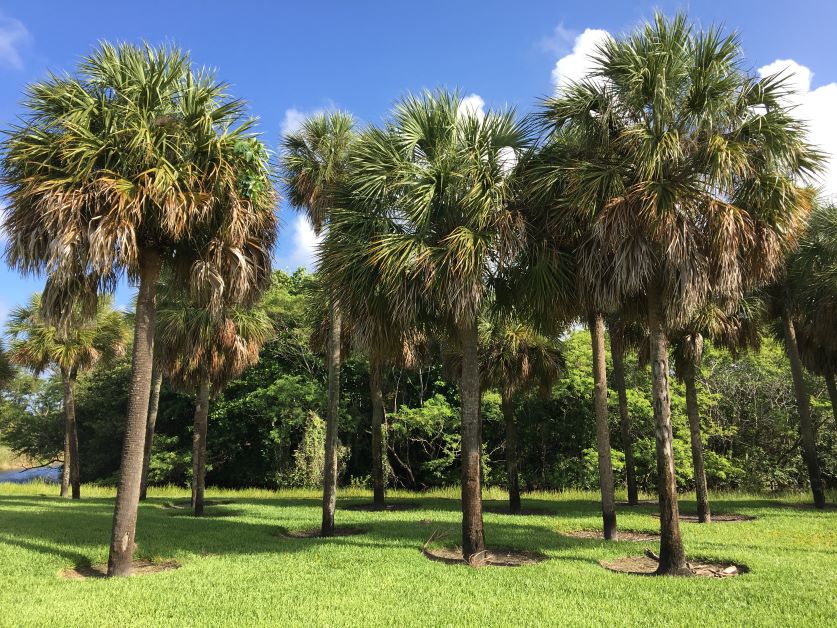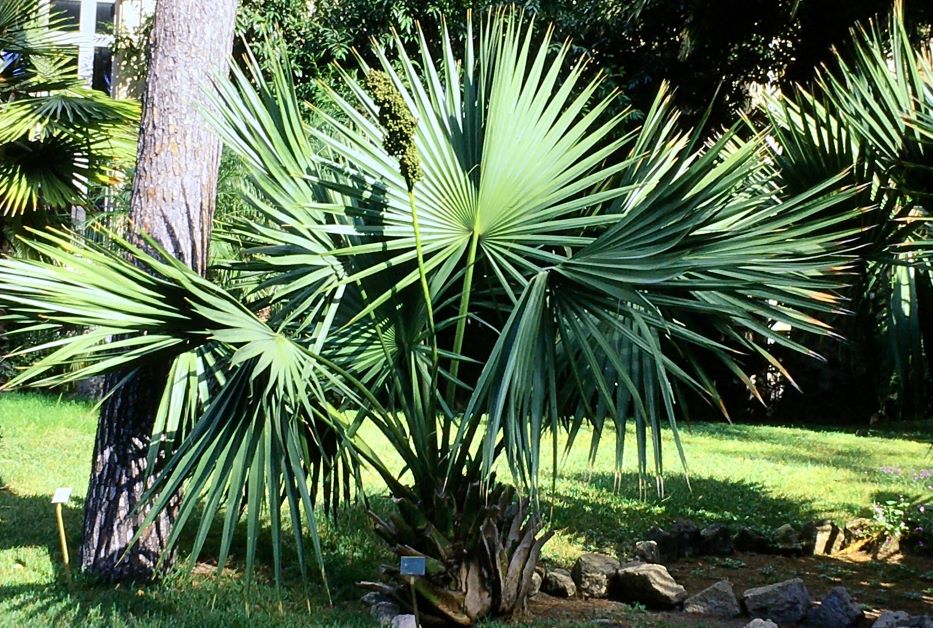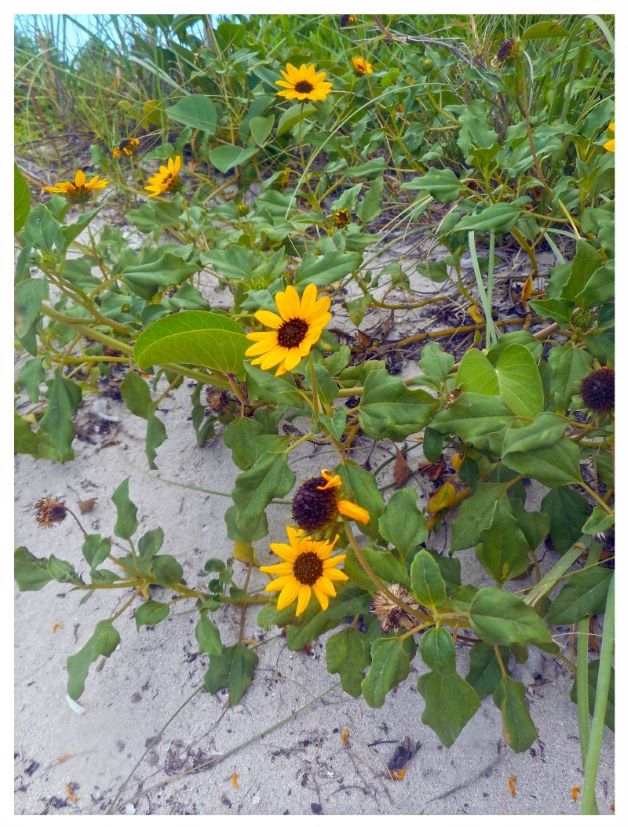The 12 Native Palm Trees of Florida
Palm trees and Florida residents have something in common: they’re both more than likely not actually from the state.
There are roughly 2600 species of palm trees in the world, and only 12 of them are native to Florida. Out of those 12, 2 are endemic. That means that these 2 trees are from Florida and from Florida only – they don’t grow naturally anywhere else in the world.
Florida Endemic Palm Trees
Scrub Palmetto (Sabal etonia)

The Florida sand pine scrub is an endangered habitat that’s home to many endemic species of plants and animals, on par with the Florida Everglades. After massive development projects and citrus grove operations, only 10-15% of sand pine scrub remains. This is where you’ll find the scrub palmetto.
The scrub palmetto is a fan palm that has a trunk that almost always grows underground. Thin stems grow from the underground trunk and have a wide, singular frond on top. It grows to be 5-10 feet tall and puts out showy white flowers during spring and early summer.
Miami Palmetto (Sabal miamiensis)
Even rarer than the scrub palmetto is the Miami palmetto. In fact, some scientists think that the Miami palmetto may be extinct in the wild (although you can find it cultivated in gardens). Before its practical extinction, the Miami palmetto grew in the rocky pinelands of Dade county.
The Miami palmetto is a lot like the scrub palmetto but with bigger fruit. It also produces 3 clusters of flowers at a time instead of the scrub palmetto’s 2.
Other Florida Native Palm Trees
Cabbage Palm (Sabal palmetto)

The cabbage palm is one of the most iconic native palm trees of Florida. In fact, it’s our state tree (and South Carolina’s, too…copycats). Unlike the fan palms on this list, the cabbage palm looks like you’d expect a palm tree would look. It grows up to 65 feet tall and has a woody trunk with a canopy of fronds on top.
The cabbage palm got its name because its inner core is edible and tastes like, you guessed it, cabbage. This part of the tree is called the heart of palm and is often used in stir-fries and salads.
You’re most likely to find cabbage palms growing in coastal areas and although it’s relatively easy to take care of, it needs hot and humid summers to thrive.
Paurotis Palm (Acoelorrhaphe wrightii)

The paurotis palm is also known as the Everglades palm because it grows in swampy areas and even in standing water. This Florida native palm tree used to be plentiful in the Everglades but is now hard to find due to illegal harvesting. Because of this, the paurotis palm is a protected species. Don’t worry: as long as you buy this specimen from a reputable nursery, it’s totally legal to grow the paurotis at home.
This is another fan palm and it likes to grow in clusters. Although the paurotis palm can reach 30 feet tall, it usually stops between 16 and 23 feet. It looks a bit like a taller version of the saw palmetto.
Needle Palm (Rhapidophyllum hystrix)

Renowned for its exceptional hardiness, the needle palm can withstand temperatures below 0F and even snow. This makes Rhapidophyllum hystrix one of a handful of palms trees that can survive winter and is an awesome choice for gardeners up north.
You’ll find the needle palm growing wild in the Southeastern U.S. (Alabama, Mississippi, Georgia, South Carolina, and Florida). It’s a shrubby, clumping palm that grows up to 8 feet tall and 8 feet wide. Instead of having a trunk, it grows slender stems from a central base.
Like the paurotis palm, the needle palm is endangered in the wild – make sure to buy it from a reputable source.
Florida Thatch Palm (Thrinax radiata)

The Florida thatch palm is a medium-sized palm that grows to about 20 feet. It’s rare to find this tree wild in Florida, but it’s more common in less developed areas of the Caribbean and Central America. If you do find it in its natural Florida habitat, you’re probably in the southernmost part of the state.
This is a slow-growing palm tree with an exceptionally long lifespan of up to 150 years. The average palm tree lifespan is usually between 70 and 80 years. Thatch palms are most often grown in medians between roads as accent trees.
Silver Palm (Coccothrinax argentata)

The silver palm is a medium, shrubby tree that usually tops out at 8 feet. Under perfect growing conditions, it can get to 30 feet tall but this is rare. A young silver palm looks like a fountain of fronds sprouting from a small, low-lying trunk. As the palm ages, the trunk gets longer, wider, and more prominent. The silver palm gets its name from the silver shiny hue on the underside of its fronds.
Due to overdevelopment, it’s harder and harder to find silver palms growing wild in Florida. Their natural Florida habitat ranges from the Lower Keys to Palm Beach.
Royal Palm (Roystonea regia)

Aptly named, the royal palm is perhaps the most ornamental of Florida’s native palm trees. It’s also the national tree of Cuba. It has a smooth trunk and beautiful, flowing fronds cascading from the top. In between the trunk and the fronds is a green column of densely packed frond bases called the crownshaft.

Royal palms are massive and average between 70 and 100 feet tall. Keep this in mind if you plant one in your landscape – keep it away from houses, power lines, and other structures. You should also keep royal palms a good distance away from walkways. Dead fronds fall off the tree from time to time which can cause injury to anyone unlucky enough to be standing underneath.
Saw Palmetto (Serenoa repens)

The saw palmetto is a low-lying palm that grows to be 5-10 feet tall and up to 10 feet wide. It’s more shrub-like than a tree, so it makes for a good understory or border plant. Wherever you grow it, keep it far enough away from paths to avoid passersby from getting poked by its spiny fronds.
Saw palmettos grow wild in all of Florida and are very easy to take care of. They’re drought-tolerant, shade-tolerant, salt-tolerant, and will thrive in a wide variety of soil types.
Buccaneer Palm (Pseudophoenix sargentii)

The buccaneer palm was common in the Florida Keys and on the Southern Atlantic coast until the early 1900s. Most specimens were gutted from their natural habitat by illegal harvesters, so this tree is now endangered. You’re more likely to find this species growing in a habitat garden than you are in the home landscape. It’s possible, though, to find a buccaneer palm for sale from a reputable tree dealer.
Buccaneer palms are cold-sensitive and only hardy to USDA zones 10B and below. They’re one of the slowest-growing palm trees on earth and usually reach a height of up to 15 feet. A lot of people grow their buccaneer palms in containers so that they can bring them inside during fall and winter.
Dwarf Palmetto (Sabal minor)

As you may have guessed, the dwarf palmetto is a lot like the saw palmetto only smaller. It also lacks the saw-like texture on the edges of its fronds. The dwarf palmetto grows on an underground trunk and gets to be about 6 feet tall and 5 feet wide.
This fan palm is common in swampy, shady places and grows wild in Florida, Texas, Arkansas, Oklahoma, Alabama, and Mexico. Like the needle palm, dwarf palmetto is tolerant to very cold weather and can withstand temperatures as low as 0F.
Key Thatch (Leucothrinax morrisii)

As its name suggests, the key thatch palm is native to the Florida Keys, along with the Bahamas, Cuba, Haiti, and Puerto Rico. It grows to 20 to 35 feet tall and produces silvery-green fronds. Although it has the potential to get quite tall, key thatch palms grow very slowly. This makes them a good choice for container and patio gardening.
Key thatch palms are hardy in zones 10B and below. As long as they have enough heat and enough sun, they’re easy to take care of and resistant to pests and diseases.
Featured Photo Credit: Forest and Kim Starr







